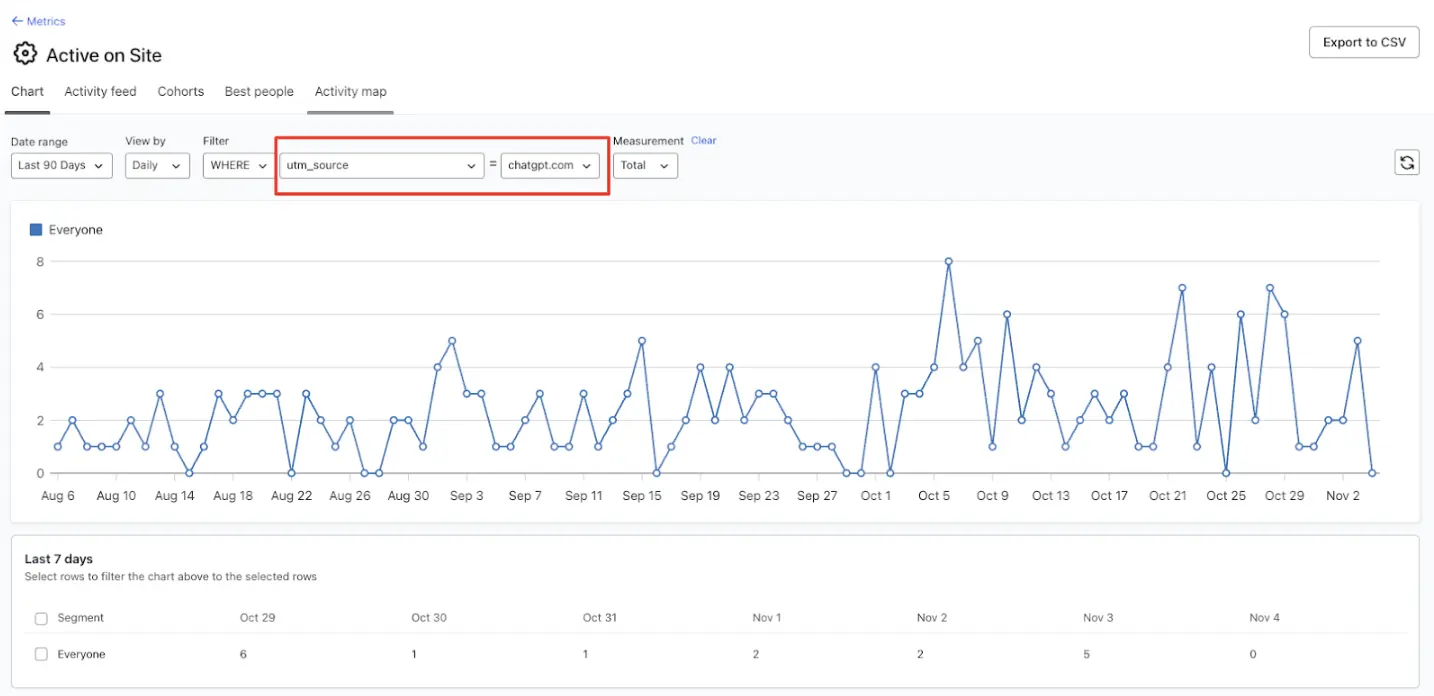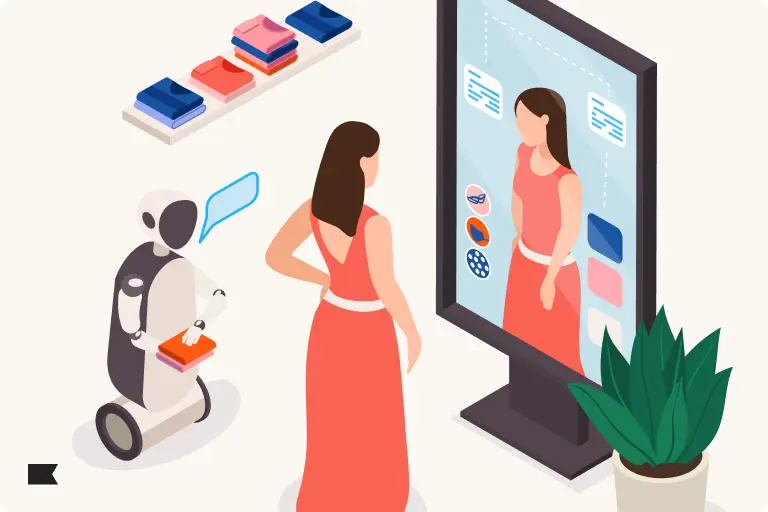Agentic shopping has arrived and it’s already in your Klaviyo account. Here’s what to do next.
Something new is starting to show up in Shopify data: visitors coming from ChatGPT.
When someone clicks a link to a brand’s site from ChatGPT, Shopify captures the referral source, and that data flows directly into Klaviyo.

That means we can now see events like checkout started and order placed from those visits. This is the very first indication of agentic shopping (i.e. consumers shopping on LLM platforms like ChatGPT) becoming a real revenue channel for brands.
Like with all other channels that a brand doesn’t own, once this data is flowing into your CRM, it’s time to start building a relationship with that consumer and turning that earned discovery into lifetime value.
But agentic shopping traffic to your site is different than traffic from channels marketers have historically focused on. It’s conversational and, likely, more likely to convert.
From conversation to connection
Think about how people use ChatGPT today. They’re not typing keywords like they do on Google. They’re having conversations.
When someone ends up on your site after a ChatGPT conversation, they’re often arriving with clear intent. They’ve already asked questions, narrowed choices, and are likely in the final mile of their purchasing decision.
Unlike other channels in which you use first-party data to target consumers, people coming to your site from LLM platforms have done their own research and landed on your product based on their real-time desires and interests. How you nurture this relationship needs to be conversational, and incredibly personalized, too.
How Shopify and Klaviyo bring it together
Because Shopify and Klaviyo already share checkout and order data, these new AI-origin visits flow right into your customer data as a UTM source.

From there, you can see who:
- Started checkout
- Placed an order
- Or browsed but didn’t buy
This makes it possible to continue that journey in a way that feels personal, relevant, and helpful, not automated or pushy. So, once you start seeing traffic from LLM platforms in Shopify and Klaviyo, it’s time to act.
4 flows that turn AI discovery into better customer journeys
1. Abandoned cart with context: Turn conversations into conversions
Audience: Users who come to your site from an LLM like ChatGPT and abandoned cart
Trigger: Started Checkout with UTM source = ChatGPT.com
Profile Filter: Has placed order = 0 times since starting this flow
Why it matters: LLM shoppers aren’t casual browsers. They’ve already told you what they want. Your job isn’t to remind them; it’s to reassure them. Think concierge, not chaser. Confirm their choice and smooth the finish line.
Flow Setup:
- Time Delay: 30 minutes after the “started checkout”.
- Conditional Split: New vs. repeat buyers.
- Sequence:
- Email 1 (30 min): Personalized reminder
- Email/SMS 2 (24 hrs): Reinforce benefits
- Email 3 (48–72 hrs): Optional incentive for new customers
Personalization tips for traffic coming from an LLM:
- Use UTM source (e.g. utm_source = ChatGPT) to segment.
- Reference their preferences directly, based on the product or specific product features: “You mentioned you wanted breathable fabrics. Your pick is still waiting.”
2. Post-purchase, personalized: Keep the conversation going
Audience: Users who come to your site from an LLM like ChatGPT and purchase
Trigger: Create a segment for when a customer places an order and has a UTM source of ChatGPT.com.
Why it matters: Post-purchase is where intent becomes trust. For AI-assisted shoppers, your follow-up should feel like a continuation of the conversation they started. This isn’t a receipt; it’s relationship design. Make it feel like you heard them.
Flow Setup:
- Email or text message 1: Thank you and confirmation (immediate)
- Email or text message 1: Educational or onboarding content (3–5 days later, depending on shipping speed)
- Email or text message 1: Review or cross-sell (7–10 days later, depending on shipping speed)
Personalization tips for traffic coming from an LLM:
- Use conversational callbacks: “You needed a weekend bag. Here’s how to make the most of it.”
- Offer next-best recommendations that align with their expressed interests or needs based on their browsing behavior tagged as coming from an LLM like ChatGPT. You can find this in the UTM_source.
- LLM platforms are known for their memory, so include “Memory Moments” in your messaging to keep the conversation going: “We remember you wanted something lightweight. This care guide keeps it that way.”
3. Browse abandonment reimagined: Follow up like a human, not a trigger
Trigger: Site abandonment with UTM source = ChatGPT.com
Filter: Has not Started Checkout or Placed Order recently
Why it matters: Conversational shoppers are evaluating options, not browsing aimlessly. Continue the dialogue they started with their AI shopping assistant. Remember, this is not retargeting. It is resuming a conversation. Consider this the baton pass from an LLM to your site.
Flow Setup:
- Time Delay: 1–2 hours after browse abandonment
- Dynamic Blocks: Product/category recommendations
- Optional Split: High- vs. low-value products
Personalization tips for traffic coming from an LLM:
- You won’t know exactly what the person talked to ChatGPT about, but it’s likely they were referred to your brand based on what your brand is known about more generally. Be sure to reference that in a message, like: “You were looking for eco-friendly options. Here are three that fit your description.”
- Offer a conversational CTA since you already know they are comfortable agentic shopping: “Want more options like this? Ask our AI stylist.”
4. Lifecycle, accelerated: Compress the funnel for conversational shoppers
Purpose: Align your flows with how consumers who are using agentic shopping actually buy, which is faster, more decisively, and with higher expectations for relevance and personalization. LLM shoppers collapse discovery and decision into one moment when they land on your site. Your flows to them should, too.
| Stage | Standard flow | Conversational upgrade |
|---|---|---|
| Discover | Welcome series | “You found us through ChatGPT. Get to know us, and our eco-friendly products, better” |
| Convert | Browse / Cart abandonment | “We saved your exact picks. Ready to checkout?” |
| Engage | Post-purchase | “You found the right item! Here’s how others are using what you just bought.” |
| Nurture | Win-back / Replenishment | “Remember when you asked ChatGPT about [product]? It might be time for a restock.” |
Preparing you for what’s next
ChatGPT sending real shoppers to Shopify stores marks a new moment in marketing, one where discovery happens through conversation, not keywords.
As the industry rushes to adapt to this new agentic era of commerce, one thing remains true: businesses want to own their customer relationships, not rent them. That’s why we’re building the AI (and into the existing AI tools) and software that let you stay independent, define your own experiences, and grow customer lifetime value across every surface where people shop, search, and chat.
The era of conversational commerce is just beginning. Klaviyo customers are already ready.

Related content

Learn how K:AI (Klaviyo AI) accelerates strategy, optimization, and customer engagement with unified data and autonomous AI built inside Klaviyo.

New York’s new AI pricing law is reshaping how brands use algorithms and customer data. Here’s why it matters—and what it means for consumer trust.

Discover the impact of AI on marketing and how brands can adapt with conversational content, personalization, and AI-powered customer experiences.